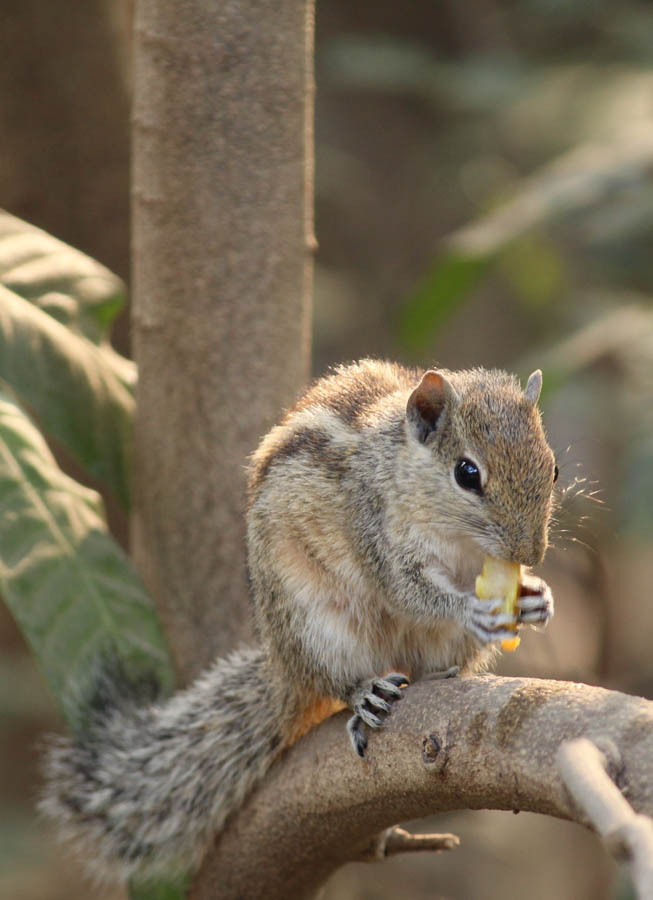Was the Damage Caused by Squirrels or Rats?

Rats in the California Home Garden
Part 4: Was the Damage Caused by Squirrels or Rats?
Squirrels and rats are among the most challenging pests in California gardens and landscapes. Both pests may be active in a single garden or landscape. Chewing, feeding, and gnawing damage in gardens and landscapes from these rodents may appear similar. How do you distinguish between them?
– Squirrels are noisy, diurnal (active during the day), and often bold. You’ll usually know if they’re causing damage because you’ll see them during the day. It’s common to see them in or near the trees or areas where they’re feeding. They climb or scamper away when you approach your trees or garden, and they’re often bold enough to chatter and scold from a safe vantage point. On the other hand, rats are shy and nocturnal. They usually become active only after dusk. Damage to fruits and vegetables from rats often appears overnight with no obvious cause or culprit. Rat damage is typically discovered in the morning or when you first check your garden the next day. If the damage to fruits and vegetables looks like it might have been caused by squirrels but you haven’t seen active squirrels out during the day, rats may be the culprit.
– Squirrel feces can be difficult to distinguish from rat feces. You may see droppings here and there that look like they might be rat feces when you have an active squirrel population around your home or on your property.
– Rats mark their pathways and trails with urine, and use the same “safe” travel routes repeatedly. Rat pathways are technically called “runs” and often include the tops of brick or cinderblock fences, utility lines, exposed piping, and areas behind bushes or within vegetation. Over time runs become stained or caked with dried rat urine. Scattered feces will tend to collect on, in, or below rat runs. Squirrels don’t produce runs. Their droppings tend to be grouped in specific areas or dispersed here and there in landscapes or under trees where they live or have been feeding.
Chewing damage from squirrels and rats may appear similar for many fruits and vegetables, and rats and squirrels may both be feeding on fruits in the same tree or vegetables in the same garden. There are subtle and in some cases obvious differences in how squirrels and rats feed:
– Squirrels often discard fruits after sampling them. They may strip a tree of its entire harvest and throw most or all of the fruit to the ground after sampling or eating a small portion of each fruit. In minor infestations, rats are more likely to damage a smaller proportion of fruit and to eat larger portions of single fruits and vegetables as they ripen. Rats often leave partly chewed fruits or some portion of the fruit or vegetable intact and attached to the tree or plant.
– Squirrels and rats differ in how they eat oranges and sweet citrus. Rats often eat out entire oranges and leave the empty peel hanging on the tree, while squirrels are more likely to leave scattered partly-eaten fruits on the ground below the tree. In my experience squirrels generally avoid eating fallen fruit or nuts when a fresh harvest is still available in trees. Rats don’t hesitate to feed on fallen fruit.
– Squirrels will eat some garden vegetables if they are hungry enough, including corn and tomatoes, but I have found this to be uncommon. Chewing damage in general to vegetables is far more likely in my experience to be caused by rats.
All articles in the GardenZeus series “Rats in the California Home Garden:”
Part 1: Norway Rats and Roof Rats
Part 2: Misconceptions about Rats
Part 3: Signs of Rats in Home and Garden
Part 4: Was the Damage Caused by Squirrels or Rats?
Part 5 (Planned): Action Plan if You Have Rats or Suspect Rats
Part 6 (Planned): Managing Rats in Gardens and Landscapes
Enter your California zip code for customized advice by plant
